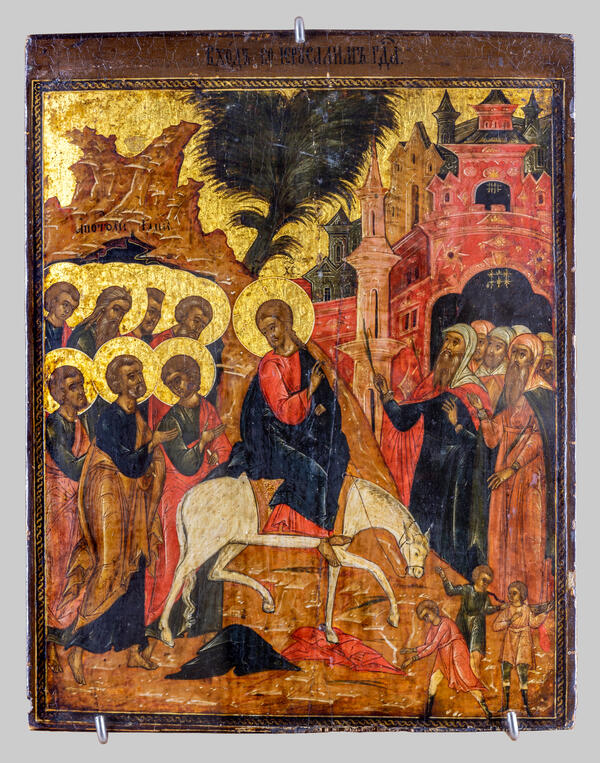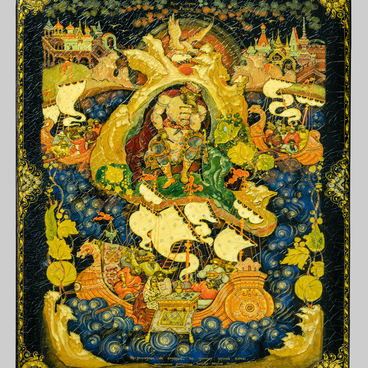The ‘Palm Sunday’ icon was created by Palekh artists in the second half of the 18th century. Local icon painters were famous for their multi-figure compositions. They were also familiar with the many ways the same iconographic plot could have been painted.
For the Palm Sunday icons, the imagery was sourced from the Gospels. They contain the information about Jesus entering Jerusalem on a young donkey on the eve of the Jewish easter. The Old Testament prophecy of the King of Israel was believed to be fulfilled at that moment: ‘Rejoice greatly, Daughter Zion! Shout, Daughter Jerusalem! See, your king comes to you, righteous and victorious, lowly and riding on a donkey, on a colt, the foal of a donkey’ (Zechariah 9:9).
This plot was depicted according to certain iconographic rules since the times of yore. Jesus enters Jerusalem, and the jews are greeting him. The Saviour is surrounded by his disciplies. He sits on a donkey, his legs facing the viewer, and looking over at the apostles. His fingers are folded in a two-fingered gesture of blessing. This iconographic tradition was predominant in 14th century Novgorod and the icons painted there at that time. It was very rarely used by artists of Yaroslavl in 18th century.
The Palekh artist depicted the apostles standing in two rows against the background of the Mount of Olives. In the center, a tree with a dense crown rises above the figure of Christ. The artist painted it with loose strokes. The children are running ahead of the donkey, throwing their clothes under its hooves. The residents of Jerusalem rush out of the gates and greet Christ with branches in their hands.
The artist painted the visages of the saints softly. He created them without visible browning or brash whitewashing, with a touch of red on their lips. The barely noticeable glare of whitewash is on the tips of their noses, on their lips, and in the outer corners of their eyes. The artist layered the semi-translucent paints, creating smooth transitions from darker shades to lighter ones. The color range is dominated by shades of ocher, brown, brown-pink, red, red-brown, blue-black and dark green. The folds of clothing are delineated with dark narrow strokes of various length and direction. The artist modelled the volume with barely noticeable application of whitewash.
Tower architecture with multicolored facades is often seen on Palekh icons of the late 18th century. Here, however, it’s not canonical imagery, but the whim of the Palekh artist.
Most of the Palekh icons use decorative elements moderately, have a harmonic color palette and low-tempo rhyme to their composition.
For the Palm Sunday icons, the imagery was sourced from the Gospels. They contain the information about Jesus entering Jerusalem on a young donkey on the eve of the Jewish easter. The Old Testament prophecy of the King of Israel was believed to be fulfilled at that moment: ‘Rejoice greatly, Daughter Zion! Shout, Daughter Jerusalem! See, your king comes to you, righteous and victorious, lowly and riding on a donkey, on a colt, the foal of a donkey’ (Zechariah 9:9).
This plot was depicted according to certain iconographic rules since the times of yore. Jesus enters Jerusalem, and the jews are greeting him. The Saviour is surrounded by his disciplies. He sits on a donkey, his legs facing the viewer, and looking over at the apostles. His fingers are folded in a two-fingered gesture of blessing. This iconographic tradition was predominant in 14th century Novgorod and the icons painted there at that time. It was very rarely used by artists of Yaroslavl in 18th century.
The Palekh artist depicted the apostles standing in two rows against the background of the Mount of Olives. In the center, a tree with a dense crown rises above the figure of Christ. The artist painted it with loose strokes. The children are running ahead of the donkey, throwing their clothes under its hooves. The residents of Jerusalem rush out of the gates and greet Christ with branches in their hands.
The artist painted the visages of the saints softly. He created them without visible browning or brash whitewashing, with a touch of red on their lips. The barely noticeable glare of whitewash is on the tips of their noses, on their lips, and in the outer corners of their eyes. The artist layered the semi-translucent paints, creating smooth transitions from darker shades to lighter ones. The color range is dominated by shades of ocher, brown, brown-pink, red, red-brown, blue-black and dark green. The folds of clothing are delineated with dark narrow strokes of various length and direction. The artist modelled the volume with barely noticeable application of whitewash.
Tower architecture with multicolored facades is often seen on Palekh icons of the late 18th century. Here, however, it’s not canonical imagery, but the whim of the Palekh artist.
Most of the Palekh icons use decorative elements moderately, have a harmonic color palette and low-tempo rhyme to their composition.



